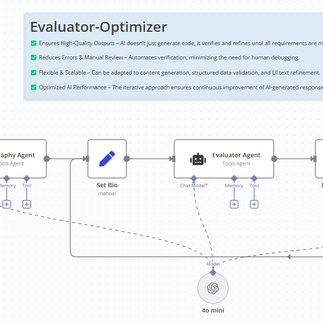Agentic AI Workflows :AI framework
- Charles Shwab
- Mar 6
- 4 min read
Agentic AI Workflows are often the brilliant AI Agents framework that expands into real team processes encompasses a sophisticated and innovative system designed to enhance collaboration, streamline workflows, and improve overall productivity within teams. This framework leverages advanced machine learning algorithms and data analytics to provide actionable insights, automate routine tasks, and facilitate communication among team members.

At its core, this AI framework is built on a foundation of robust data integration, allowing it to gather and analyze information from various sources, including project management tools, communication platforms, and performance metrics. By synthesizing this data, the AI can identify patterns, predict potential bottlenecks, and recommend strategies to optimize team performance.
Moreover, the framework is designed to adapt to the unique dynamics of each team. It takes into account individual roles, strengths, and weaknesses, thereby promoting a more personalized approach to task allocation and collaboration. This adaptability ensures that the AI can effectively support diverse teams, whether they are engaged in software development, marketing campaigns, or research projects.
The most basic AI agents are designed to operate using just a single SOP, limited to 4 to 6 connected tools. It's crucial to recognize that agents can function within a framework.
AI Agents Frameworks:
The simplest of all AI agents are designed to operate with a focused approach, typically ready to work on a single Standard Operating Procedure (SOP) at any given time. This streamlined functionality allows them to be highly efficient, as they are restricted to utilizing only 4 to 6 specific tools that are directly connected to the SOP they are tasked with handling. This limitation, rather than being a drawback, enables these agents to hone in on their designated tasks with precision and clarity. It is crucial to understand that even though these agents may seem basic in their operation, they can effectively work within various frameworks that enhance their capabilities and ensure optimal performance. Some of the frameworks that facilitate the operation of these agents are outlined below, providing insight into how they can be structured to maximize efficiency and output:
Routing framework for many AI Agents: This framework allows for the systematic directing of tasks among multiple AI agents, ensuring that each agent is assigned the most appropriate job based on its specific capabilities and the requirements of the SOP. This routing mechanism can significantly improve the overall workflow by distributing tasks according to the strengths of each agent.
Parallelization framework of AI Agents: In this framework, multiple AI agents can operate simultaneously on different aspects of a project or SOP. By leveraging parallel processing, the overall time taken to complete complex tasks is reduced, as various agents work concurrently rather than sequentially. This approach is particularly beneficial in scenarios where time efficiency is critical, allowing for faster turnaround times and increased productivity.
Prompt Chaining of AI Agents: Prompt chaining involves linking the outputs of one AI agent to the inputs of another, creating a seamless flow of information and tasks. This framework enables a more sophisticated level of interaction between agents, allowing them to build upon each other's work. By utilizing prompt chaining, the agents can collectively tackle more complex problems that require a series of steps to reach a final solution, thereby enhancing their overall effectiveness.
Evaluator Optimizer of AI Agents: This framework focuses on the continuous assessment and improvement of the performance of AI agents. By implementing evaluators that can analyze the outputs of the agents, adjustments can be made to optimize their processes and responses. This iterative feedback loop ensures that the agents are not only performing their tasks but are also evolving and improving over time, leading to higher quality results and more refined operational capabilities.
In addition to enhancing efficiency, the AI framework fosters a culture of continuous improvement. By providing real-time feedback and facilitating regular check-ins, it encourages team members to reflect on their processes and outcomes. This iterative approach not only helps in refining team strategies but also empowers individuals to take ownership of their contributions.
Furthermore, the integration of AI into team processes promotes transparency and accountability. Team members can easily track progress, monitor deadlines, and assess the impact of their work. This visibility not only builds trust among team members but also enables leaders to make informed decisions based on comprehensive data insights.
Ultimately, a brilliant AI framework that expands into real team processes is not just about technology; it is about transforming the way teams operate. By harnessing the power of artificial intelligence, organizations can create an environment where collaboration flourishes, innovation thrives, and teams can achieve their goals more effectively and efficiently than ever before.
We have explained each of the framework in below articles in detailed.
Subscribe to our blog to get started with advanced level implementation of AI Agents.













Comentarios